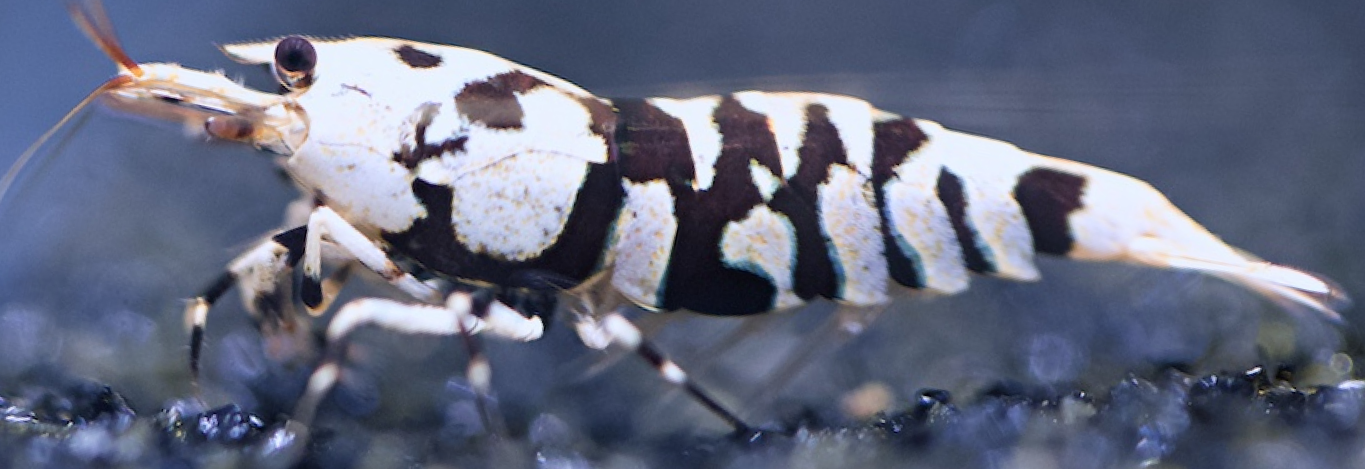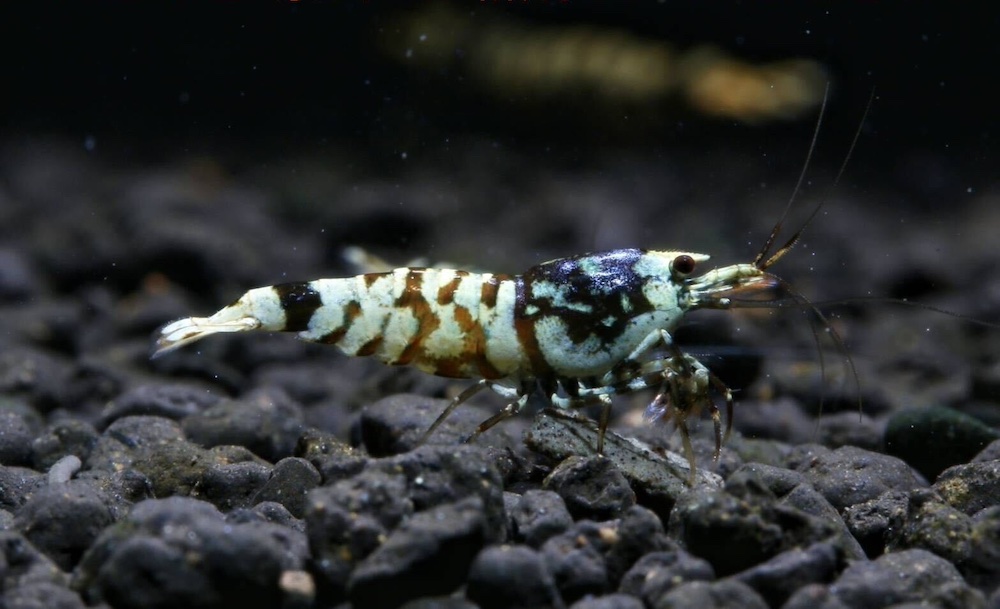Fancy tiger shrimp have become a popular and stunning addition to the aquarium hobby over the past decade. Initially, these shrimps were not particularly attractive, which spurred breeders to refine their appearance. This refinement process, involving meticulous breeding and selection, transformed them into the beautiful specimens we see today.
The creation of fancy tiger shrimp is a testament to the dedication and skill of breeders. The process begins with crossing different shrimp species and involves selecting the best offspring, further crossing, and inbreeding to achieve the desired traits. This intricate work ensures that the shrimp not only display stunning colors but also maintain hardiness and health.
The Origins of Fancy Tiger Shrimp
Cross between Crystal Red shrimps and Super Tiger shrimp.
In 2008, Hwa Shrimp (Yang Zhenhua 楊振華) first experimented with the creation of this variant. Fancy tiger shrimp originated from a deliberate crossbreeding of crystal red shrimp (Caridina cantonensis) and super tiger shrimp (Caridina mariae). This combination aimed to blend the striking colors of crystal red shrimp with the robust patterns of super tiger shrimp, leading to the development of the first generation (F1) of fancy tiger shrimp.
Initial F1 generation shrimp
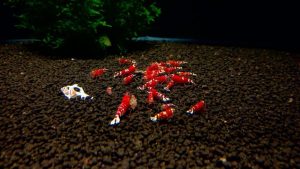 The initial F1 generation shrimp exhibited a brownish body with tiger-like stripes and white specks, with minimal red coloration due to the dominance of black from the tiger shrimp. Although the results were not visually pleasing, the lower grades were not culled. When innovating new variants, it’s best to keep even the lower grades as backup genetics for future experimentation. Yang Zhenhua selectively crossed these F1 shrimp with the original crystal red parent to enhance the red and white colors. Through multiple generations of selective breeding and inbreeding, Yang Zhenhua refined the shrimp’s appearance. In 2014, he publicly announced the Tiger Shrimp, but at that time, it was known as the “Rampage” (暴走系) variant.
The initial F1 generation shrimp exhibited a brownish body with tiger-like stripes and white specks, with minimal red coloration due to the dominance of black from the tiger shrimp. Although the results were not visually pleasing, the lower grades were not culled. When innovating new variants, it’s best to keep even the lower grades as backup genetics for future experimentation. Yang Zhenhua selectively crossed these F1 shrimp with the original crystal red parent to enhance the red and white colors. Through multiple generations of selective breeding and inbreeding, Yang Zhenhua refined the shrimp’s appearance. In 2014, he publicly announced the Tiger Shrimp, but at that time, it was known as the “Rampage” (暴走系) variant.
Breeding Methods and Selection Process
Breeders start by selecting F1 generation shrimp that display the most promising traits in terms of color and pattern. These selected specimens are then crossbred back with the original parent shrimp, often crystal red shrimp, to intensify the desired red and white coloration. The process involves careful observation and selection to ensure the offspring progressively exhibit more refined and vivid patterns.
The first instance of the Fancy Tiger was known as the “Rampage” variant. Yang Zhenhua selectively bred and crossed the brightest reds and black shrimp back with the original lineage. In order to achieve this variant, he did not bring in outside genetics. Because of the limited genetic diversity throughout multiple generations, the “Rampage” variant was genetically delicate.
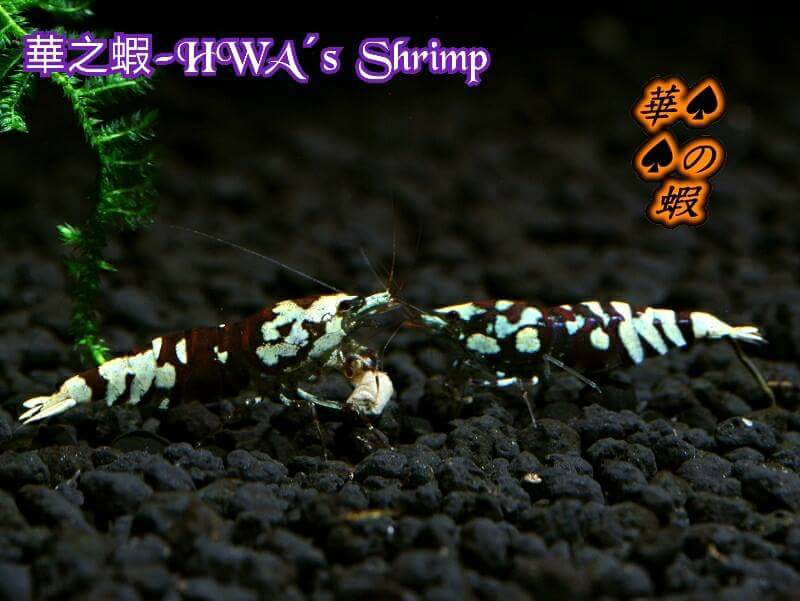
But the stage was set, the initial physical characteristics of the Fancy Tiger were developed and breeding true. After the introduction of the “Rampage” variant in 2014, breeders further crossed this lineage with others to increase the genetic diversity and strength. Ultimately creating the vibrant and hardy fancy tiger shrimp admired in the hobby today.
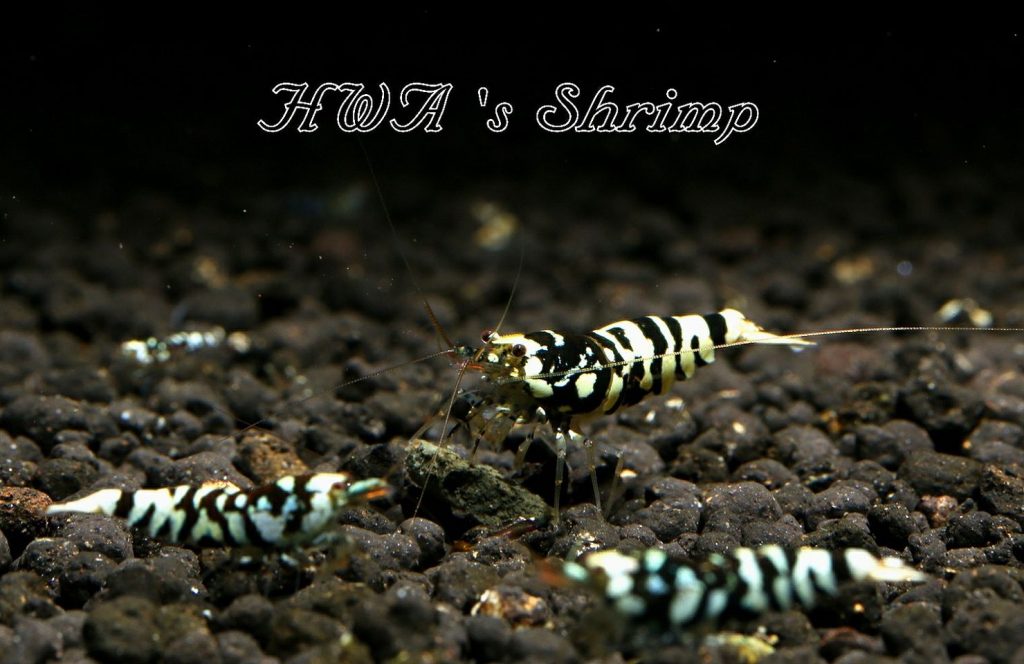
Introduction of Galaxy Tiger shrimp into breeding pools for color enhancement.
Some breeders have introduced Galaxy Tiger shrimp into the breeding pools to enhance the coloration of fancy tiger shrimp. Although this can introduce new and vibrant colors, it is considered unorthodox as it may compromise the purity of the bloodline with Pinto genes. This method requires a delicate balance to ensure the introduction of new traits does not dilute the desired lineage characteristics.
Maintaining Purity in Fancy Tiger Bloodlines
Maintaining purity in fancy tiger bloodlines is a debatable topic since none of the original “Rampage” lineage descendants are known to exist today. But dedicated breeders still aim to preserve the specific traits that define the evolved Fancy Tiger variant. Pure bloodlines ensure consistency in coloration, patterns, and overall quality, which are highly valued by breeders and enthusiasts alike. Pure lines are also more predictable in terms of breeding outcomes and genetic health.
Identifying fancy tigers with Pinto blood and the challenges
Identifying fancy tigers with Pinto blood involves close examination of the shrimp’s patterns and coloration. Pinto-influenced shrimp often display distinctive irregular patterns and colors that deviate from the standard fancy tiger appearance. This identification process can be challenging, requiring experienced breeders to discern subtle differences and maintain strict breeding protocols to avoid unintentional crossbreeding.
Intensification of Base Colors
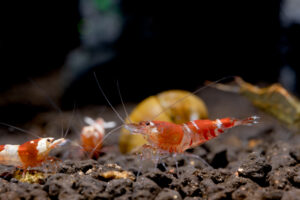
Experimentation involving crosses with super red and super black shrimp
Breeders have conducted experiments by crossing fancy tiger shrimp with super red and super black shrimp to enhance the intensity of the base colors. These crosses aim to amplify the vibrant red and deep black hues, making the shrimp more visually striking. This method has been successful in producing shrimp with more intense and vivid colors. The enhanced color traits have been well-received in the aquarium hobby, leading to its continued practice among breeders.
Black Fancy Tigers: A Striking Variant
The introduction of Black Fancy Tigers marks another significant milestone in the evolution of fancy tiger shrimp. While the exact timeline of their development is not clearly documented, these striking variants have become a popular choice among shrimp enthusiasts in recent years.
Black Fancy Tigers are characterized by their predominantly black body, which can range from a deep, solid black to a rich, dark blue-black hue. Black fancy tigers retain the distinctive tiger striping or patterns, in contrasting white and black creating a striking appearance.
Black Fancy Tigers are believed to have emerged from selective breeding programs focused on intensifying the black coloration present in some fancy tiger shrimp. Breeders likely selected individuals with the darkest pigmentation over multiple generations, gradually producing shrimp with deeper and more uniform black coloration.
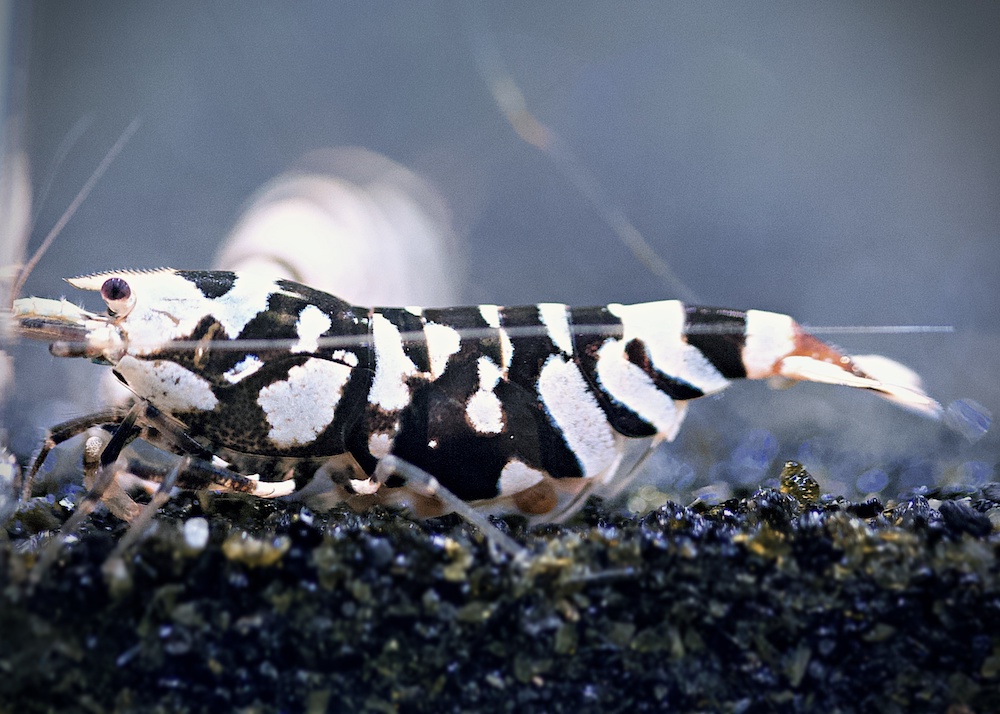
Lava Tigers: A Revolutionary Breakthrough
In the ever-evolving world of ornamental shrimp breeding, Lava Tigers represent a groundbreaking achievement that has taken the shrimp-keeping community by storm. First introduced in 2023 by the renowned breeder Yang Zhenhua in Taiwan, Lava Tigers showcase the pinnacle of selective breeding in Caridina shrimp and fancy tigers.
The development of the Rampage variant, although too delicate, was not created in vain. Yang Zhenhua continued to evolve this variant by crossing it with other variants to unveil the Lava Tiger.
Lava Tigers are characterized by their striking appearance, featuring a black or metallic purple/black carapace adorned with intricate patterns and white splashes. Their body displays the elegant stripes reminiscent of fancy tigers, with thick, solid white bands set against a deep red or burgundy background. This unique combination of colors and patterns makes them truly stand out in the aquarium.
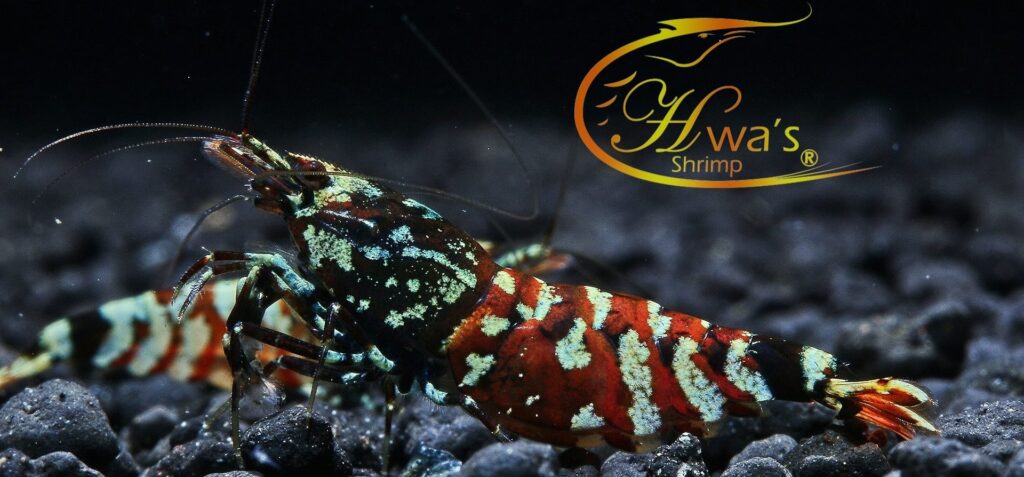
What sets Lava Tigers apart is the successful combination of two dominant traits – the red and black coloration – in a single specimen. This feat, achieved through six years of meticulous selective breeding, marks a significant milestone in Caridina breeding. The ability to consistently produce offspring with these traits demonstrates the advanced breeding techniques employed by Yang Zhenhua.
As of mid-2024, Lava Tigers remain extremely rare in the hobby. Their limited availability and the complexity of their breeding have resulted in exceptionally high market values, with single competition-grade specimens reportedly ranging from $3,000 to $6,000 USD.
The development of Lava Tigers opens up exciting possibilities for the future of fancy tiger shrimp breeding. As more breeders attempt to work with this rare genetic line, we may see further variations and refinements of these striking shrimp in the coming years.
The introduction of Lava Tigers represents not just a new variety of shrimp, but a testament to the skill, patience, and innovation of dedicated breeders in the shrimp hobby. Their emergence showcases the ongoing evolution of fancy tiger shrimp and the continuous push for new and stunning varieties in the world of caridina shrimp keeping.
The Appeal of Fancy Tiger Shrimp
Fancy tiger shrimp are admired for their striking appearance, featuring vivid colors and intricate patterns. Additionally, they are relatively affordable compared to other exotic shrimp varieties, making them accessible to a wide range of hobbyists. The hardiness of fancy tiger shrimp is attributed to their tiger shrimp genes, which make them more resilient and easier to care for than some other Caridina species. This robustness adds to their appeal, especially for beginners. Given their stunning appearance, affordability, and hardiness, fancy tiger shrimp are an excellent choice for enthusiasts looking to add vibrant life to their Caridina tanks. They offer both aesthetic beauty and ease of care, making them a rewarding addition.

